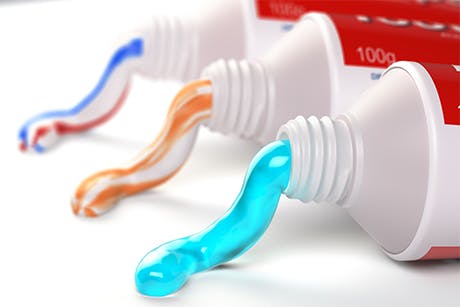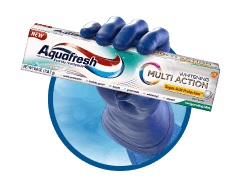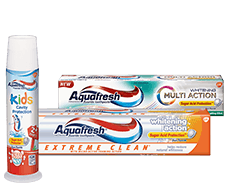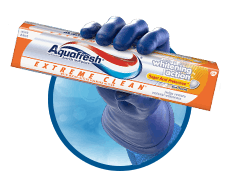Types of Toothpaste and How to Pick One
Combined with flossing or interdental cleaning, brushing with toothpaste plays a key part in your daily dental hygiene routine.1 Toothpastes contain the same basic components: a mild abrasive to remove debris and stains, humectants to prevent water loss in the paste itself, detergent to create foaming, flavoring and thickening agents.1 While the basic components remain the same across most toothpastes, additional ingredients are added to help different oral health objectives, such as:1
- Decay Prevention
- Gum Health
- Desensitizing
- Whitening

If you’re overwhelmed by the options and can’t decide which category makes sense for your oral health, talk to your dental professional to see if you have any specific conditions that require a specific type of toothpaste.2
Decay Prevention Toothpaste
Tooth decay is when the hard outer layer of your tooth, called enamel, breaks down.This is a result of the accumulation of plaque on the tooth surface that isn’t brushed away on a routine basis. When you consume food and drinks, a sticky film of bacteria, called plaque, forms on your teeth. The bacteria create acid that attack your teeth enamel.3
Since plaque is so sticky, it keeps the acid in contact with your teeth unless you do something to remove it. Professional dental cleanings will remove plaque, but you should also help prevent tooth decay at home by using toothpaste containing fluoride in your daily brushing routine.3
Toothpastes that are designed to help prevent cavities, also known as tooth decay, contain fluoride. Fluoride is present in many foods, available as a dietary supplement and is commonly added to community drinking water sources in the US.9 Fluoride in toothpaste can reduce the risk of dental caries, or cavities, by slowing the demineralization of your teeth’s enamel.9 Fluoride also helps strengthen existing tooth enamel.9 An excellent example of this is Aquafresh Cavity Protection Fluoride Toothpaste!
Gum Toothpaste
Gum disease is an infection of the gingival tissues supporting your teeth.5
Gingivitis is the early, reversible stage of gum disease, which is often characterized by swollen gums that often bleed when brushing your teeth.5 Periodontal disease is the more advanced stage of gum disease—when the tissues and bones supporting your teeth weaken so much that your teeth may loosen.5 Periodontitis, or advanced gum disease, affects 47.2% of adults over the age of 30 in the United States.5
These are some symptoms of gum disease.5
- Gums that bleed when you brush
- Red, swollen gums
- Gums that have pulled away from teeth
- Persistent bad breath or taste
- Permanent teeth that are loose or separating
- Changes in the way your teeth fit together when you bite
- Changes in the fit of partial dentures
Desensitizing Toothpaste
Teeth can become sensitive to triggers like temperature and pressure when the protective layers of enamel and cementum are worn down, exposing an inner part of the tooth called dentin.6 The dentin contains microscopic tubules that can allow triggers like temperature to affect the nerves within the tooth.6 Tooth sensitivity can be caused by tooth decay, fractured teeth, worn fillings, gum disease and more.6
Desensitizing toothpaste contains compounds that help block transmission of sensations from the tooth surface to the nerve.6 You won’t feel the effects right away, but following the directions on the package can help reduce dentin hypersensitivity.
In addition to desensitizing toothpaste, follow these brushing techniques to prevent sensitive teeth.7
- Use desensitizing toothpaste containing stannous fluoride or sodium fluoride with potassium nitrate.
- Brush with small, circular movements.
- Use a soft bristled brush and change it every two to three months.
- Brush your teeth at night before bed and one other time during the day.
- Brush an hour after you eat rather than right after. Some foods can soften your teeth enamel and make it easier to be removed with brushing.
Whitening Toothpaste
Teeth can lose their white luster over time for a variety of reasons. Teeth may stain from food, drinks or tobacco use.8 As you age, your enamel may thin and allow the yellowish dentin so show through.8 Additionally, if you’ve been hit in the mouth, your tooth may lay down more yellow colored dentin as a reaction to the trauma.8 Finally, some treatments like chemotherapy and some medications like antihistamines, antipsychotics and high blood pressure medicines may also cause the tooth to darken.8
Whitening toothpastes are formulated to help reduce stains through the use of mild abrasives that scrub the surface of the teeth.8 Whitening toothpastes may work on surface stains but probably won’t work for other types of discoloration, especially if your tooth discoloration is caused by medications or tooth injury.8 Consult a dental professional to determine if using a whitening toothpaste is good for you.
Occasionally, some people experience tooth sensitivity after using whitening products. If this happens, take a break from the toothpaste and consult your dentist about your whitening toothpaste for expert guidance—overuse of whiteners can damage tooth enamel or gums.
Check for the ADA Seal of Acceptance
As a good rule of thumb, always look for the ADA Seal of Acceptance on the packaging when choosing a toothpaste.2
The American Dental Association seal of acceptance will indicate that the toothpaste has been independently tested for safety and effectiveness.
Source Citations:
- Toothpaste. Mouth Healthy. https://www.mouthhealthy.org/all-topics-a-z/toothpaste. Accessed on 5/24/23
- What Kind of Toothpaste Should I Use. Mouth Healthy. https://www.mouthhealthy.org/dental-care-concerns/what-kind-of-toothpaste-should-i-use. Accessed on 5/24/23.
- Tooth Decay. Mouth Healthy. https://www.mouthhealthy.org/all-topics-a-z/tooth-decay. Accessed on 5/24/23.
- Fluoride. Dental Health. https://www.dentalhealth.org/fluoride. Accessed on 5/24/23.
- Gum Disease. Mouth Healthy. https://www.mouthhealthy.org/all-topics-a-z/gum-disease. Accessed on 5/24/23.
- Sensitive Teeth. Mouth Healthy. https://www.mouthhealthy.org/all-topics-a-z/sensitive-teeth. Accessed on 5/24/23.
- Sensitive Teeth. Dental Health. https://www.dentalhealth.org/sensitive-teeth. Accessed on 5/24/23.
- Teeth Whitening. Mouth Healthy. https://www.mouthhealthy.org/all-topics-a-z/teeth-whitening. Accessed on 5/24/23.
- Fluoride Fact Sheet for Health Professionals. US Department of Health and Human Services. https://ods.od.nih.gov/factsheets/Fluoride-HealthProfessional/. Accessed 10/31/23.
Am I Flossing Correctly?




Aquafresh® Multi Action® Whitening can help brighten your smile in no time.

Get 75¢ off any one Aquafresh® product.

Check out more from Captain Aquafresh® to learn how to fight cavities.

Learn more about your oral health and how Aquafresh®helps keep you feeling clean.






